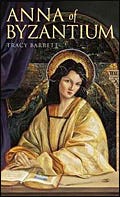The real Anna of Byzantium was the eldest child of a Byzantine emperor. She was bright, and her parents gave her an excellent education. Until her brother John was born, she and the boy her parents intended her to marry were in line to become the next empress and emperor. The novel Anna of Byzantium imagines what it might have been like to grow up believing you would one day be an empress and then have the prize snatched away by a younger brother.
Readers will sympathize with Anna as she tries to please both her pious mother and her scheming, power-hungry grandmother, who often give her conflicting instructions. Anna wins less sympathy with her haughty, sometimes mean behavior to the slaves and servants who work to educate her and make her life comfortable. But though pampered in some ways, Anna too must obey many exotic rules and restrictions. She must bow to her mother, father and grandmother, and sometimes prostrate herself before her father, stretching face down on the floor. She learns to keep secrets. At eleven, when her grandmother declares her a woman and gives her a veil, Anna thinks "what an advantage the veil would be in disguising my emotions."
In order to tell a less complicated story, many events in the novel happen when Anna is either older or younger than the historical Anna was when they actually took place. Some historical events are left out. Anna's younger brother was probably less horrible than in the book, and Anna was probably more ruthless. But readers gain a strong impression of the strange customs and stranger challenges of life in a Byzantine court, which make for fascinating reading. (1999; 209 pages, including an Author's Note separating history from fiction. Recommended for ages 10 and up.)




